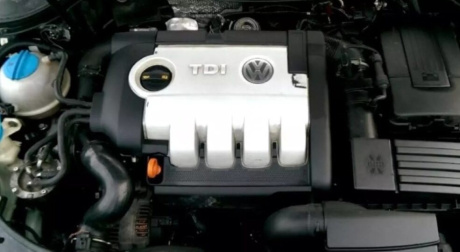
The 2.0 TDI (EA188) is a four-cylinder diesel engine from Volkswagen. The engine is fundamentally built the same as the 1.9 TDI, but it has a slightly larger displacement. The fuel mixture preparation is carried out using VW's developed pump-nozzle system. The timing is controlled via a timing belt, which has a replacement interval depending on the year of manufacture, at either 74,565 miles or 93,206 miles.
2.0 TDI Engine Technical Specs
| MKB | Displacement | Power | Torque | Introduction |
| AZV | 120.1 cu in | 100 kW (136 hp) / 4,000 RPM | 236 lb-ft / 1,750 – 2,500 RPM | 2003 |
| BMA, BVH | 120.1 cu in | 100 kW (136 hp) / 4,000 RPM | 236 lb-ft / 1,800 – 2,500 RPM | 2005 |
| BGW, BHW | 120.1 cu in | 100 kW (136 hp) / 4,000 RPM | 247 lb-ft / 1,900 RPM | 2003 |
| BKD, BLB, BRE, BKP | 120.1 cu in | 103 kW (140 hp) / 4,000 RPM | 236 lb-ft / 1,750 – 2,500 RPM | 2004 |
| BRT | 120.1 cu in | 103 kW (140 hp) / 4,000 RPM | 229 lb-ft / 1,900 – 2,500 RPM | 2005 |
| BMP | 120.1 cu in | 103 kW (140 hp) / 4,000 RPM | 236 lb-ft / 1,800 – 2,500 RPM | 2005 |
| BMM | 120.1 cu in | 103 kW (140 hp) / 4,000 RPM | 236 lb-ft / 1,750 – 2,500 RPM | 2008 |
| BMN, BMR, BKQ, BUY, BRD | 120.1 cu in | 125 kW (170 hp) / 4,200 RPM | 258 lb-ft / 1,750 – 2,500 RPM | 2005 |
Typical 2.0 TDI (EA188) Typical Problems
The 2.0 TDI has been used in numerous models of the VW, Audi, Skoda, and Seat brands. Unlike the 1.9 TDI, the two-liter suffers from some issues that, if left untreated, can lead to a total engine failure. Below, we have summarized the most known problems.
Crack in the Cylinder Head

The 2.0 TDI occasionally experiences cylinder head cracks, which are indicated by a loss of coolant or, at that point, it may already be too late. Affected are the variants with 140 hp (engine code BKD) and with 170 hp (engine code BMN), with older versions seeming to be affected by this problem more frequently than newer ones.
Defective Oil Pump
Another serious problem is caused by the hexagonal shaft in the oil pump drive. This tends to wear prematurely, leading to a sudden failure of the oil pump and a lack of lubrication in the engine.
The consequence of this is usually a total engine failure, but at the very least, a destroyed turbocharger. Particularly affected are 2.0 TDIs of the older model years (often with the code BMP).
Defective EGR Valve

Power loss in the 2.0 TDI is usually due to a clogged or defective EGR valve. Whether it is worth cleaning or replacing this depends entirely on the condition of the component.
On one hand, cleaning the EGR valve, whose components are not too worn, can achieve a similar effect as replacing the part. On the other hand, improper cleaning of the exhaust gas recirculation valve can lead to permanent damage in both the 2.0 TDI and any other engine.
Carbon Buildup

Carbon Buildation on the injectors and in the EGR valve can lead to costly repairs, especially in diesel vehicles. To prevent this or at least delay it, the preventive use of cleaning fuel additives, which are added at regular intervals when refueling, is recommended.
List Of Cars Equipped With 2.0 TDI (EA188) Engine
- Audi A3 (8P)
- Audi A4 (B7)
- Audi A6 (C6)
- Jeep Patriot
- Volkswagen Golf MK5
- Volkswagen Jetta Mk5
- Volkswagen Passt B6
Conclusion
One should not blindly purchase a 2.0 TDI of the EA188 series – especially not if the service booklet has not been maintained or is completely missing. Before buying, it is also important to find out which engine code the desired vehicle has, to at least avoid engines at risk of cylinder head cracks.
See Also:
Same articles

Understanding Vehicle Inspection and Verification Services: Why They Matter for Every Driver
GuidesVehicle inspection and verification services are an essential but often overlooked part of keeping roads safe and cars legally compliant. Most people only think about inspections when it’s...
KLIFEX Brand Overview: High-Quality Automotive Repair Kits for Affordable Repairs
GuidesThe automotive aftermarket has long needed solutions that combine reliability, durability, and affordability. Many car enthusiasts and services are looking for a way...
Fast, Reliable Vehicle Emissions & Inspection Services Made Simple
GuidesFast, reliable emissions and inspection services are essential for keeping vehicles road-ready, compliant with environmental regulations, and safe for daily driving. If you’re looking for quick...

